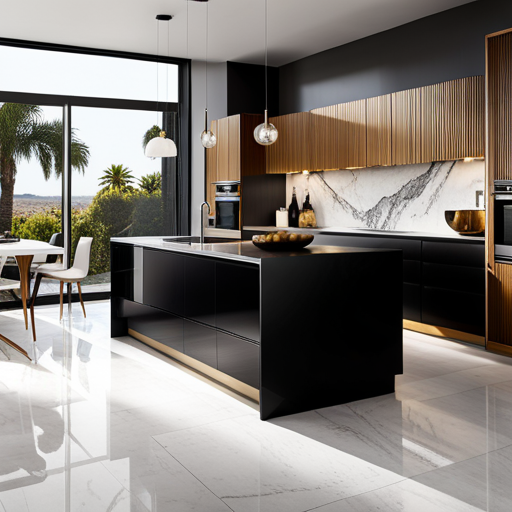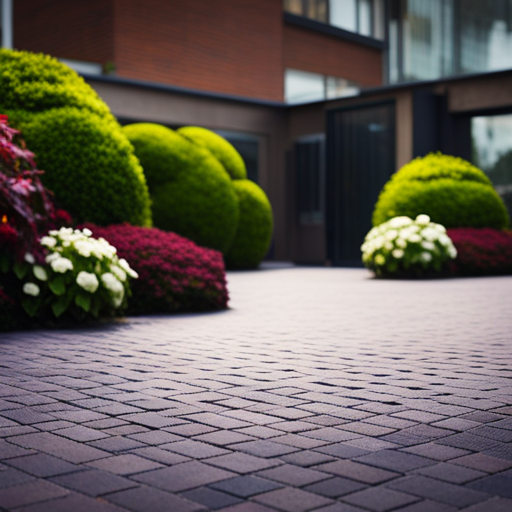Comparing Porcelain and Ceramic Tile Flooring

Comparing porcelain and ceramic tile flooring involves evaluating their durability, water absorption, maintenance, cost, installation, design options, and environmental impact.
Understanding the distinctions between these popular flooring materials is crucial for making informed decisions about home or commercial renovations. By examining these key factors, consumers can confidently select the most suitable tile flooring for their specific needs and preferences.
Durability
The water absorption characteristics of porcelain and ceramic tiles are another important aspect to consider when choosing the right option for a specific space. Porcelain tiles have a lower water absorption rate compared to ceramic tiles, making them more resistant to water damage. This makes porcelain tiles suitable for areas with high moisture levels, such as bathrooms and kitchens, where water spills and splashes are common. On the other hand, ceramic tiles have a higher water absorption rate, making them more prone to water damage and staining. Therefore, ceramic tiles are more suitable for dry areas, such as living rooms and bedrooms, where water exposure is limited. It is important to consider the specific needs and conditions of the space when deciding between porcelain and ceramic tiles in terms of water absorption. By understanding the water absorption characteristics of these tiles, you can ensure that the flooring choice is suitable for the intended area and will provide long-lasting performance.
Water Absorption
When it comes to water absorption, porcelain tiles have a significantly lower absorption rate compared to ceramic tiles.
This difference in water absorption can have a direct impact on the overall durability and performance of the flooring.
Understanding the implications of water absorption is essential in making an informed decision between porcelain and ceramic tile flooring.
Porcelain’s Low Absorption
Porcelain tile flooring exhibits remarkably low water absorption rates, making it an ideal choice for areas prone to moisture and high-traffic environments. Its moisture resistance and low absorption properties make it highly suitable for bathrooms, kitchens, and outdoor spaces.
The low water absorption also contributes to the stain resistance of porcelain tiles, requiring minimal maintenance and cleaning. To maintain its pristine appearance, regular sweeping and occasional mopping with a mild detergent are usually sufficient. For tougher stains, a mixture of water and vinegar or a commercial porcelain cleaner can be used.
The low absorption characteristic of porcelain not only enhances its durability but also simplifies its upkeep, making it a preferred option for residential and commercial flooring where moisture and heavy foot traffic are common concerns.
Ceramic’s Higher Absorption
With regards to water absorption, ceramic tile flooring exhibits higher rates compared to porcelain, making it imperative to consider the moisture vulnerability of the installation area. When considering ceramic tile flooring, there are several important factors to take into account:
-
Moisture Resistance: Due to its higher water absorption rate, ceramic tile may not be suitable for areas prone to moisture, such as bathrooms, kitchens, or outdoor spaces.
-
Surface Finish: The higher water absorption of ceramic tiles can make them more susceptible to staining. It’s important to choose a surface finish that offers adequate protection against moisture penetration and staining.
-
Maintenance Requirements: More frequent sealing and maintenance may be necessary to protect ceramic tiles from moisture-related damage and to ensure their longevity in high-moisture environments.
Impact on Durability
Given the higher water absorption rate of ceramic tile flooring, it is essential to assess its impact on durability, particularly in areas susceptible to moisture. When comparing the impact on aesthetics and strength, porcelain tiles, with their lower water absorption rate, generally maintain their appearance and structural integrity better than ceramic tiles in damp environments. The table below summarizes the comparison of these two types of tile flooring in terms of water absorption, impact on aesthetics, and strength.
| Aspect | Porcelain Tile | Ceramic Tile |
|---|---|---|
| Water Absorption | Low | High |
| Impact on Aesthetics | Maintains well | Prone to damage |
| Comparison of Strength | Higher | Lower |
Understanding the implications of water absorption on durability is crucial in making an informed decision when choosing between porcelain and ceramic tiles. This assessment will guide the subsequent discussion on maintenance.
Maintenance
To maintain both porcelain and ceramic tile flooring, regularly sweep or vacuum to remove dirt and debris, and clean with a mild detergent and water solution. Additionally, consider the following maintenance tips for long-lasting, beautiful tile floors:
-
Cleaning Products:
- Use cleaning products specifically designed for tile floors.
- Avoid harsh chemicals or abrasive cleaners, as they can damage the tile’s surface or grout.
- Select pH-neutral cleaning solutions that effectively remove dirt and stains without causing harm to the tile.
-
Grout Sealing:
- Properly seal the grout lines to prevent moisture and dirt from penetrating and causing discoloration or mildew.
- Grout sealers create a protective barrier that helps maintain the grout’s appearance and prolong its lifespan.
- Reapply the sealer as needed to ensure ongoing protection.
-
Regular Maintenance:
- In addition to routine cleaning, periodically inspect the grout for any signs of wear or damage.
- Address any issues promptly to prevent further deterioration and maintain the overall integrity of the tiled surface.
Cost
The average cost of porcelain tile flooring installation is approximately $5 to $10 per square foot. Ceramic tile flooring typically ranges from $4 to $8 per square foot.
When considering the cost comparison between porcelain and ceramic tile flooring, it’s important to note that porcelain tiles are generally more expensive than ceramic tiles due to their denser and more durable nature.
However, the installation process for both types of tiles is quite similar. It involves preparing the subfloor, applying mortar, laying the tiles, grouting, and sealing.
The installation cost can vary depending on factors such as the complexity of the project, location, and the specific requirements of the subfloor.
It’s essential to factor in not only the initial cost of the tiles but also the installation expenses when making a cost comparison between porcelain and ceramic tile flooring.
Additionally, homeowners should consider the long-term benefits and durability of porcelain tiles, which may justify the higher initial investment.
Installation
When it comes to the installation of porcelain and ceramic tile flooring, there are several key points to consider.
These include the durability and longevity of the materials, as well as the maintenance and cleaning requirements.
Understanding these factors is essential for making an informed decision about which type of tile is best suited for a specific space.
Durability and Longevity
An important factor in evaluating the durability and longevity of porcelain and ceramic tile flooring during installation is the use of high-quality grout and adhesives to ensure a lasting and stable floor surface. When comparing the durability and longevity of porcelain and ceramic tile flooring, several crucial aspects need consideration:
-
Scratch Resistance and Maintenance Requirements: Porcelain tiles are highly scratch-resistant and have lower maintenance requirements compared to ceramic tiles. This makes them suitable for high-traffic areas and reduces the need for frequent maintenance.
-
Wear and Tear, Lifespan Comparison: Porcelain tiles generally have a longer lifespan than ceramic tiles due to their denser and more durable nature. They are better equipped to withstand heavy foot traffic and are less prone to chipping and cracking.
-
Proper Installation Techniques: Ensuring proper installation techniques, such as using high-quality grout and adhesives, is essential for maximizing the durability and longevity of both porcelain and ceramic tile flooring.
Considering these factors during installation can significantly impact the long-term performance of the flooring.
This leads to the subsequent section about ‘maintenance and cleaning’.
Maintenance and Cleaning
Discussing proper maintenance and cleaning is essential when installing porcelain and ceramic tile flooring.
Both types of tile are relatively low-maintenance, requiring regular cleaning to maintain their appearance and durability.
Ceramic tile is typically more porous than porcelain, making it more susceptible to stains. As such, applying protective coatings can enhance its stain resistance.
When it comes to grout maintenance, both types of tile require regular cleaning to prevent discoloration. Cleaning techniques may vary, but a mixture of water and mild detergent is generally suitable for routine cleaning. For tougher stains, specific cleaners designed for either porcelain or ceramic tiles can be used.
Understanding the differences in maintenance and cleaning aspects can help homeowners make informed decisions when choosing between porcelain and ceramic tile flooring.
Design Options
Design options for porcelain and ceramic tile flooring vary widely, offering an extensive range of styles to suit any aesthetic preference. When considering the design of porcelain and ceramic tile flooring, individuals can choose from a wide array of options such as:
-
Color Options: Both porcelain and ceramic tiles come in a vast spectrum of colors, allowing homeowners and designers to select the perfect shade to complement their space. From bold and vibrant hues to subtle and neutral tones, there is a color option to suit every design scheme.
-
Pattern Choices: These tiles are available in various patterns, including intricate designs, geometric shapes, and classic motifs. Whether one desires a contemporary, traditional, or eclectic look, there is a pattern to match every style preference.
-
Finish Varieties: Porcelain and ceramic tiles are available in different finishes such as matte, glossy, textured, and metallic, providing versatility in achieving the desired aesthetic and functionality.
The design options for porcelain and ceramic tile flooring are extensive, allowing individuals to create unique and personalized spaces. When considering the design aspect, it is essential to also evaluate the environmental impact of these flooring options.
Environmental Impact
The environmental impact of porcelain and ceramic tile flooring includes considerations of material sourcing, production processes, and long-term sustainability.
In terms of material sourcing, both types of tiles are typically made from natural materials such as clay, sand, and other recycled materials. However, ceramic tiles often require less energy-intensive processing due to their lower firing temperature compared to porcelain tiles. This contributes to their overall environmental sustainability.
Furthermore, manufacturing processes play a significant role in the environmental impact of these flooring options. Energy efficiency is a key factor to consider, as it directly affects the carbon footprint of the production. Ceramic tiles generally have an advantage in this aspect, as their production tends to be less energy-intensive.
Long-term sustainability is another crucial consideration. Both porcelain and ceramic tiles are highly durable, which means they have a long lifespan and reduced need for replacement. This durability contributes to the environmental sustainability of these flooring options by reducing the overall material usage and waste.
Frequently Asked Questions
Are Porcelain and Ceramic Tiles Suitable for Outdoor Use?
Porcelain and ceramic tiles are suitable for outdoor use due to their durability and low maintenance. Their installation cost may vary depending on the type and size, but both are viable options for outdoor applications.
Can Porcelain or Ceramic Tiles Be Used in High-Traffic Areas?
In high-traffic areas, the choice between porcelain and ceramic tiles is crucial. Durability and maintenance play a pivotal role, while design and cost considerations also come into play. Careful evaluation is essential for longevity and aesthetics.
How Do Porcelain and Ceramic Tiles Hold up in Areas With Extreme Temperature Fluctuations?
Porcelain and ceramic tiles are both durable options for areas with extreme temperature fluctuations. They are resistant to temperature changes and can withstand the stresses of such environments. Proper maintenance is essential for maximizing their longevity.
Are Porcelain and Ceramic Tiles Suitable for Use in Wet Areas Such as Bathrooms and Kitchens?
Porcelain and ceramic tiles are suitable for wet areas like bathrooms and kitchens due to their low moisture absorption, slip-resistant properties, and durability. They require minimal maintenance, making them ideal for high-traffic and moisture-prone areas.
What Are the Differences in the Environmental Impact of Porcelain and Ceramic Tile Production?
The environmental impact of porcelain and ceramic tile production varies due to differences in material composition and manufacturing processes. Understanding these distinctions is crucial for making informed decisions about sustainable building materials and minimizing ecological footprints.
Conclusion
In conclusion, both porcelain and ceramic tile flooring offer durability, low water absorption, easy maintenance, and a range of design options.
While porcelain may be more costly and difficult to install, it provides a higher level of durability and is more environmentally friendly.
On the other hand, ceramic tile offers a more affordable option with easier installation.
Ultimately, choosing between the two is like comparing a sturdy oak tree to a delicate cherry blossom – both beautiful in their own way, but with unique qualities to consider.

Rubin Everest, a seasoned expert in the world of flooring, brings a wealth of knowledge and passion to the surface. As the mind behind ebbow.com, Rubin is dedicated to sharing insights on the latest trends, innovative solutions, and expert advice in the realm of flooring. Whether you’re seeking practical tips for installation or design inspiration, Rubin Everest is your go-to source for all things flooring-related, making your journey to the perfect floor an informed and enjoyable experience.





